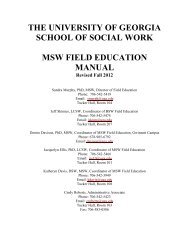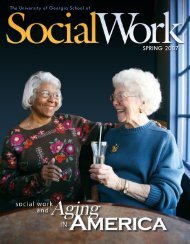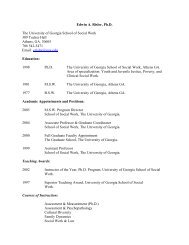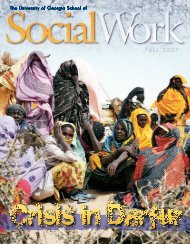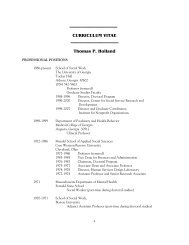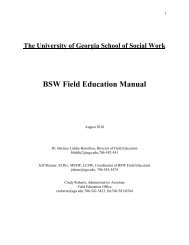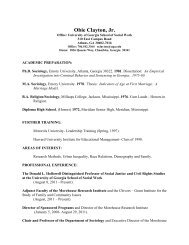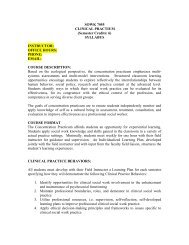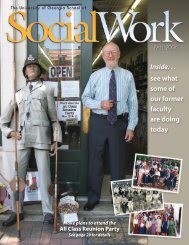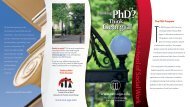Developing Self-Efficacy in MSW Students Through Service-Learning
Developing Self-Efficacy in MSW Students Through Service-Learning
Developing Self-Efficacy in MSW Students Through Service-Learning
Create successful ePaper yourself
Turn your PDF publications into a flip-book with our unique Google optimized e-Paper software.
<strong>Develop<strong>in</strong>g</strong> <strong>Self</strong>-<strong>Efficacy</strong> 1Runn<strong>in</strong>g head: SELF-EFFICACY THROUGH SERVICE-LEARNING<strong>Develop<strong>in</strong>g</strong> <strong>Self</strong>-<strong>Efficacy</strong> <strong>in</strong> <strong>MSW</strong> <strong>Students</strong> <strong>Through</strong> <strong>Service</strong>-Learn<strong>in</strong>g: Year 2Nancy R. Williams, Ph.D.University of GeorgiaSchool of Social WorkAthens, GA 30602nwilliam@uga.eduEllen R. Cox, <strong>MSW</strong>University of GeorgiaSchool of Social WorkAthens, GA 30602ellenrhea@yahoo.comJeffrey J. Koob, Ph.D.California State University, Long BeachDepartment of Social WorkLong Beach, CAjkoob@csulb.eduUnpublished paperThe first author can be reached at the School of Social Work, The University of Georgia, 419 TuckerHall, Athens, GA, 30602-7016; email: nwilliam@arches.uga.edu; phone: 706-542-3938; fax: 706-542-6644. Special thanks to Hilary Copp and Nancy Kropf for their editorial assistance and to the studentparticipants for their enthusiastic <strong>in</strong>volvement <strong>in</strong> this project.
<strong>Develop<strong>in</strong>g</strong> <strong>Self</strong>-<strong>Efficacy</strong> 2AbstractWhile social work education has rich historical roots <strong>in</strong> service-learn<strong>in</strong>g <strong>in</strong> the work of Jane Addams,this form of experiential education with<strong>in</strong> master of social work curricula is relatively rare. Some haveanecdotally described this approach as be<strong>in</strong>g <strong>in</strong>terchangeable with the mandated field practicum.Proponents suggest that service-learn<strong>in</strong>g provides social work students with an alternative learn<strong>in</strong>gexperience outside of the traditional classroom <strong>in</strong> which they can <strong>in</strong>crease their perceived self-efficacyspecifically <strong>in</strong> preparation for their professionally-focused field practicum. In this follow-up study <strong>in</strong>the second year of a service-learn<strong>in</strong>g course for <strong>MSW</strong> students, students who functioned as volunteers<strong>in</strong> a camp for burn-<strong>in</strong>jured children were compared to a group of their cohorts who weresimultaneously enrolled <strong>in</strong> classroom courses. All students were adm<strong>in</strong>istered the Social Work <strong>Self</strong><strong>Efficacy</strong> Scale, the <strong>Self</strong> <strong>Efficacy</strong> Scale and the Rosenberg <strong>Self</strong>-Esteem Scale pre and post. Results<strong>in</strong>dicate that both groups of students <strong>in</strong>creased their self-efficacy suggest<strong>in</strong>g that a service-learn<strong>in</strong>gapproach may be a viable educational alternative for build<strong>in</strong>g perceived self-efficacy <strong>in</strong> social workstudents.
<strong>Develop<strong>in</strong>g</strong> <strong>Self</strong>-<strong>Efficacy</strong> 3<strong>Develop<strong>in</strong>g</strong> <strong>Self</strong>-<strong>Efficacy</strong> <strong>Through</strong> <strong>Service</strong>-Learn<strong>in</strong>g: Year 2The field of social work education has a rich legacy <strong>in</strong> community service <strong>in</strong> the work of socialwork pioneer and Nobel laureate, Jane Addams. Addams’ philosophy exemplified the notion of“learn<strong>in</strong>g by do<strong>in</strong>g” through community-centered practice as embodied <strong>in</strong> her hallmark work,Chicago’s Hull House. Goldste<strong>in</strong> (2001), a contemporary voice <strong>in</strong> social work education, asserts thatexperiential education, with its foundation <strong>in</strong> the democratic and humanistic theories of Dewey, Friere,Foucault, and Gardener, “returns us to the roots of social work <strong>in</strong> Addams’ terms” (p. 134). <strong>Service</strong>learn<strong>in</strong>g,as a model of experiential education that has been ga<strong>in</strong><strong>in</strong>g <strong>in</strong> popularity across a variety ofprimarily non-social work doma<strong>in</strong>s <strong>in</strong> higher education <strong>in</strong> recent decades, can be viewed as an obviousheir to Addams’ vision.The National and Community <strong>Service</strong> Act of 1990 describes service-learn<strong>in</strong>g as participatorylearn<strong>in</strong>g through organized service experiences that addresses community needs by way of acollaborative process between the school and community. Research has l<strong>in</strong>ked service-learn<strong>in</strong>g to thedevelopment and enhancement of civic responsibility, moral development, and academic performanceamong participat<strong>in</strong>g students (Gray, Ondaatje, & Zakaras, 1999; Markus, Howard, & K<strong>in</strong>g, 1993;Tucker, McCarthy, Hoxmeier, & Lenk, 1998). Other studies have provided evidence of <strong>in</strong>creased selfesteemand cultural awareness (Weah, Simmons, & Hall, 2000), improved sense of empowerment(Giles & Eyler, 1994), enhanced self-confidence (Forte, 1997), improved problem-solv<strong>in</strong>g skills(Zlotkowski, 1996), <strong>in</strong>creased motivation to learn (Berson & Younk<strong>in</strong>, 1998), and improvedcommunication skills (Tucker et al., 1998). Ironically, while these areas of research are highly relevantto social work education, much of the research has been conducted with courses unrelated to socialwork and have <strong>in</strong>cluded such discipl<strong>in</strong>es as bus<strong>in</strong>ess (Zlotkowski, 1996), political science (Markus etal., 1993), sociology (Morton & Troppe, 1996), and communications (Cohen & K<strong>in</strong>sey, 1994).
<strong>Develop<strong>in</strong>g</strong> <strong>Self</strong>-<strong>Efficacy</strong> 4With<strong>in</strong> the current social work education field, however, service-learn<strong>in</strong>g is anecdotally viewedby social work educators as <strong>in</strong>terchangeable with the field practicum, a pivotal, experientially based,and mandated model for professional tra<strong>in</strong><strong>in</strong>g and development. Field placements typically occur <strong>in</strong> avariety of social work sett<strong>in</strong>gs as a way to <strong>in</strong>tegrate academic coursework with practice skilldevelopment. However, it has been posited that while the field practicum offers a rich and <strong>in</strong>tegrativeprocess of learn<strong>in</strong>g, it is a different learn<strong>in</strong>g experience than service learn<strong>in</strong>g (Kropf & Tracey, 2000).The field practicum is primarily focused on the student’s specific skill development as a practitioner,and the overarch<strong>in</strong>g goal for students <strong>in</strong> field placement is to focus on the student’s professional skilldevelopment coupled with the enhancement of their professional social work identity (Bogo & Vayda,1998). The field agency provides a laboratory for the student’s learn<strong>in</strong>g and while there may beoverlaps and benefits derived by the community, these are secondary to student learn<strong>in</strong>g needs. Theorganization becomes the vehicle to assist the student <strong>in</strong> this process and it occurs under the watchfulsupervision of an experienced social worker. While community service may be part of the tasksperformed, reciprocity with the community and the implicit lessons of civic responsibility is not thespecific goal even if it is a possible by-product (Nnakwe, 1999). In fact, it is more common to hearcompla<strong>in</strong>ts from field <strong>in</strong>structors that students come to their placements unprepared for professionalpractice. Some researchers have even suggested that service learn<strong>in</strong>g courses can better prepareMaster’s level students for their practicum “jobs” (Kropf & Tracey, 2000).In contrast to the traditional field practicum, a service-learn<strong>in</strong>g course focuses on l<strong>in</strong>k<strong>in</strong>gstudents with activities that are meant to enhance the community irrespective of role-based learn<strong>in</strong>gneeds on the part of the student. As such, conceptually, service-learn<strong>in</strong>g may hold a particularfamiliarity for social workers, as many of the learn<strong>in</strong>g situations are compatible with social workpractice. However, while the learn<strong>in</strong>g focus <strong>in</strong> traditional classroom coursework typically <strong>in</strong>volves
10 th International Conference on Urban Dra<strong>in</strong>age, Copenhagen/Denmark, 21-26 August 2005organisation, as each scientific partner is <strong>in</strong> charge of the cont<strong>in</strong>uous contact with local endusers;this means numerous rem<strong>in</strong>ders via e-mail and telephone to the local partners. Thedelays caused by the difficulties <strong>in</strong> f<strong>in</strong>d<strong>in</strong>g common meet<strong>in</strong>g dates for partner and end-users,seem to be m<strong>in</strong>or <strong>in</strong> national terms, but are accumulat<strong>in</strong>g at the project scale and result <strong>in</strong>difficulties <strong>in</strong> terms of project progress.On the other side, end-users compla<strong>in</strong> not to be sufficiently <strong>in</strong>formed on the overall projectadvancement. It was stated that the bi-annual DayWater newsletter does not conta<strong>in</strong> enoughdetailed <strong>in</strong>formation and therefore does not replace a regular contact between the nationalscientific partner and the end-users, which demands availabilities on both sides. Despite<strong>in</strong>vit<strong>in</strong>g all CEU to the annual project meet<strong>in</strong>gs and present<strong>in</strong>g them the demonstrations of allavailable ADSS components, their knowledge about the DayWater project is often limited tothe component developed by their respective national scientific partner.Common def<strong>in</strong>ition of ADSS structure and functionalitiesThe <strong>in</strong>tr<strong>in</strong>sic difficulties of a multidiscipl<strong>in</strong>ary and mult<strong>in</strong>ational project are obvious. First ofall, even when scientific partners were work<strong>in</strong>g <strong>in</strong> the same field, there is a common languageto be found for the project <strong>in</strong>herent terms. It took a long time before every partner becameaware of such language problems. Such misunderstand<strong>in</strong>gs were both related to the commonuse of the English language, and to different cultural approaches, such as the way to beunderstood outside the scientific field. Different professional backgrounds may causedifferent def<strong>in</strong>ition of technical and trivial terms. Nearly all partners have experience <strong>in</strong><strong>in</strong>ternational projects and should therefore be aware of these k<strong>in</strong>ds of problems, but there isstill a gap between the simple knowledge of the existence of these problems and the realisedawareness and result<strong>in</strong>g behaviour. A cautious behaviour means verification of e-mails orreports directly with the responsible person, <strong>in</strong> case of seem<strong>in</strong>gly offensive statements. Thereis clearly a lack of understand<strong>in</strong>g to be stated, which might be due to little will<strong>in</strong>gness, towork overload or to ignorance of <strong>in</strong>tercultural differences. Thus the personal encounters,dur<strong>in</strong>g numerous work meet<strong>in</strong>gs, were found necessary for the success of the DayWaterdevelopment.Development of ADSS componentsThe ambition and expectations on the ADSS prototype were differ<strong>in</strong>g a lot dur<strong>in</strong>g the firsttwo project years. At the beg<strong>in</strong>n<strong>in</strong>g of the project, it was difficult to have a realistic frame ofall the <strong>in</strong>teractions <strong>in</strong> the project due to its complexity. Each partner developed “his”components mostly <strong>in</strong>dependent to the other components and their mutual requirements. TheToR of the ADSS was expected to remediate this problem, demand<strong>in</strong>g every componentdeveloper to describe his requirements and his contribution to the other components and to thegeneral ADSS structure. The partners felt not able to do so, as the <strong>in</strong>ter-relations were onlydiscovered step by step, parallel to their development. This is <strong>in</strong> contradiction to the functionof the ToR, which should be the reference document to the prototype development.Furthermore the <strong>in</strong>itial work plan did not specifically mention the dates of delivery of eachADSS component. This omission made it difficult to make each partner understand theconsequences, caused by delays with<strong>in</strong> elaboration of their component specification andimplementation <strong>in</strong> the Web based ADSS tool.Attention to decision-mak<strong>in</strong>g proceduresThe analysis of the decision-mak<strong>in</strong>g process (DMP) <strong>in</strong> USWM projects is a good example forthis <strong>in</strong>tercultural and <strong>in</strong>terdiscipl<strong>in</strong>ary misunderstand<strong>in</strong>g (Deutsch et al., 2004). Consultanteng<strong>in</strong>eers conceive the DMP <strong>in</strong> a different way than researchers and south European countriesdo not consider the DMP as north Europeans do. Thus it was found necessary to <strong>in</strong>tegrate, <strong>in</strong>D. Thévenot & M. Förster 5
<strong>Develop<strong>in</strong>g</strong> <strong>Self</strong>-<strong>Efficacy</strong> 6task (Bandura, 1977, 1982, 1986, 1997), is fostered <strong>in</strong> a variety of educational sett<strong>in</strong>gs. There is apredictive element <strong>in</strong>volved <strong>in</strong> self-efficacy, an expectation of a positive outcome based on a sense ofperceived competency (Holden, Meenaghan, Anastas, & Metrey, 2002). This suggests that studentswho perceive themselves as capable will subsequently attempt, perform, and complete tasks betterthan those who perceive themselves as less capable.In social work education, self-efficacy is highly associated with the valued goal of selfawarenessthat is often fostered <strong>in</strong> experiential educational activities both <strong>in</strong> and out of the classroomsett<strong>in</strong>g. This construct, as it is emphasized <strong>in</strong> social work, is an understand<strong>in</strong>g of one’s impact onothers as well as an accurate self-perception of abilities and limitations. Gibbs and Gambrill (1999)give voice to a common refra<strong>in</strong> <strong>in</strong> the social work field as they stress the importance of self-knowledgedescribed as a “knowledge of [one’s] personal strengths and limitations that <strong>in</strong>fluence how oneapproaches problem solv<strong>in</strong>g and decision mak<strong>in</strong>g” (p. 11). Perceived self-efficacy is a related conceptand is a particular form of self-assessment (Holden et al., 2002). In a previously mentioned study with<strong>MSW</strong> students (Williams et al., 2002), students who participated <strong>in</strong> the service-learn<strong>in</strong>g courseexhibited a statistically significant <strong>in</strong>crease <strong>in</strong> perceived self-efficacy related to social work practiceskills and tasks.Research QuestionsThe purpose of this follow-up study is to explore the effects of a service-learn<strong>in</strong>g course on theperceived self-efficacy of <strong>MSW</strong> students <strong>in</strong> year two of the course. The follow<strong>in</strong>g questions areaddressed:1. What are the effects of a service-learn<strong>in</strong>g course on the perceived self-efficacy ofmaster of social work students who participated <strong>in</strong> it?
<strong>Develop<strong>in</strong>g</strong> <strong>Self</strong>-<strong>Efficacy</strong> 72. What are the effects of traditional classroom courses on the perceived self-efficacyof master of social work student cohorts who participated <strong>in</strong> them simultaneously?3. What are the contrasts between the two groups?MethodThe CampCamps for burn-<strong>in</strong>jured children are creative programs that have emerged over the last 20years. The camps were orig<strong>in</strong>ally developed to address psychosocial needs <strong>in</strong> a safe, normaliz<strong>in</strong>g andactivity-focused environment and currently over 40 camps exist <strong>in</strong> the US with more <strong>in</strong> Canada,Europe, Australia, and New Zealand. These camps ideally offer the children and youth who attend theopportunity to develop supportive relationships with adults and other campers who are familiar andcomfortable with burn <strong>in</strong>juries. Some of these adults may be burn-<strong>in</strong>jured themselves and many areconnected with the fire service. While there are philosophical differences among burn camps, onevalue that is shared universally is the importance of community (Doctor, 1992).The camp <strong>in</strong> this study, staffed completely by volunteers, is open to any child <strong>in</strong> the state whohas suffered a severe burn and has spent at least four days <strong>in</strong> either of the state’s two burn units. It wasestablished <strong>in</strong> 1992 by the state firefighters’ burn foundation, a grass-roots non-profit organizationcomprised of firefighters from around the state who work year-round to raise the money to fund thecamp as well as organize and facilitate the camp activities. The nationally recognized camp has grownto serve over 100 children annually and is staffed by nearly 150 volunteers. The volunteer communityis primarily male and comprised of mostly firefighters or emergency service workers (EMT), with asmaller group of <strong>in</strong>dividuals who are medical burn unit personnel, a few adult burn survivors, andother <strong>in</strong>terested <strong>in</strong>dividuals above the age of 21. While some of the burn camps are rehabilitative <strong>in</strong>focus, just as many are exclusively recreational, as is the one <strong>in</strong> this study (Doctor, 1992). At this
<strong>Develop<strong>in</strong>g</strong> <strong>Self</strong>-<strong>Efficacy</strong> 10<strong>Service</strong>-learn<strong>in</strong>g group. <strong>Students</strong> were required to attend two pre-camp orientation sessionssponsored by the camp, attendance at camp for the entire eight days as well as two class meet<strong>in</strong>gs priorto camp and a de-brief<strong>in</strong>g session one week after camp ended. The student participants signed aconsent form and all students who signed up for the class agreed to participate <strong>in</strong> the study. Theparticipants represented a non-probability sample, as all volunteered for the class. The service-learn<strong>in</strong>ggroup were adm<strong>in</strong>istered the <strong>in</strong>struments dur<strong>in</strong>g the first pre-camp class meet<strong>in</strong>g with the primary<strong>in</strong>vestigator <strong>in</strong> attendance. The first class additionally consisted of group development, courseoverview, and social work skill development relevant to practice with burn-<strong>in</strong>jured children. Thesecond class took place at the Burn Foundation office where they received an overview from medicalpersonnel, firefighters and burn survivors about the process of burn recovery. Follow<strong>in</strong>g the serviceexperience, the students received and completed the post-assessment dur<strong>in</strong>g a debrief<strong>in</strong>g session alsoconducted by the primary <strong>in</strong>vestigator and research assistant.Classroom group. <strong>Students</strong> enrolled <strong>in</strong> the classroom courses described above attended asummer school schedule <strong>in</strong> which the courses were offered <strong>in</strong> four-hour blocks over an eight-weekperiod. Courses followed a syllabus that comb<strong>in</strong>ed lecture, read<strong>in</strong>gs, exams, written assignments, andclassroom discussion. Packets were left <strong>in</strong> student boxes of the students who were identified as hav<strong>in</strong>gsigned up for a summer course by the school registrar. The packets conta<strong>in</strong>ed an explanation of theproject, consent forms, a demographic form, and three <strong>in</strong>struments. Only those students who returnedthe packets with completed <strong>in</strong>struments were <strong>in</strong>cluded <strong>in</strong> the study.Participants <strong>in</strong> both groups were provided with a randomly generated subject number that wasused to code both the pre- and post-assessments. This number was used <strong>in</strong>stead of the students’ names<strong>in</strong> an attempt to ma<strong>in</strong>ta<strong>in</strong> confidentiality. The primary <strong>in</strong>vestigator and research assistant adm<strong>in</strong>isteredthe dependent measures described below to all participants at both the pre- and post-assessments to
<strong>Develop<strong>in</strong>g</strong> <strong>Self</strong>-<strong>Efficacy</strong> 11help reduce random error. All of the measures were scored after the post-assessment was complete andall <strong>in</strong>struments were accounted for to help control for possible experimenter bias.InstrumentsThree dependent measures were used: 1) The Social Work <strong>Self</strong>-<strong>Efficacy</strong> Scale (SWSES)(Williams et al., 2002); 2) The Rosenberg <strong>Self</strong>-Esteem Scale (RSE) (Rosenberg, 1979); and 3) The<strong>Self</strong>-<strong>Efficacy</strong> Scale (SES) (Sherer et al., 1982). The RSE and the SES were primarily employed <strong>in</strong> thestudy to test the SWSES for construct validity, and all three measures were adm<strong>in</strong>istered at pre andpost.Social Work Perceived <strong>Self</strong>-<strong>Efficacy</strong> Scale. Quantitative data was gathered us<strong>in</strong>g a scaleconstructed to measure the perceived self-efficacy of social work students at the Master’s level.Adopt<strong>in</strong>g a method suggested <strong>in</strong> the professional literature by Koob (1998), content was drawn fromthe list of core competencies for social workers at the Master’s level as mandated by the Council onSocial Work Education (CSWE, 1994). Because self-efficacy theory asserts that expectations ofpersonal mastery are specific to a target behavior (Bandura, 1997), each item on the scale reflects arelevant social work skill or task that are reflected <strong>in</strong> the course objectives of the courses offered <strong>in</strong> thecurriculum.The Social Work <strong>Self</strong>-<strong>Efficacy</strong> Scale is a 47-item self-report measure (see Appendix A). Eachitem is scored Yes or No, <strong>in</strong>dicat<strong>in</strong>g whether the respondent uses the skill or not. For each item scoredas Yes, a 0-100 rat<strong>in</strong>g is provided <strong>in</strong>dicat<strong>in</strong>g the respondent’s perceived confidence perform<strong>in</strong>g theskill. Higher rat<strong>in</strong>gs <strong>in</strong>dicate a higher degree of perceived confidence. The rat<strong>in</strong>gs are then totaled anddivided by the number of items answered as Yes, with higher scores <strong>in</strong>dicat<strong>in</strong>g a higher degree ofperceived self-efficacy.
<strong>Develop<strong>in</strong>g</strong> <strong>Self</strong>-<strong>Efficacy</strong> 12The development of this scale was primarily theory-based, and, due to the small sample size,no attempt to assess <strong>in</strong>ternal consistency by calculat<strong>in</strong>g alpha coefficients or determ<strong>in</strong>e test-retestreliability was made. In an attempt to measure validity, however, the scale was tested for correlationswith two standardized measures: the <strong>Self</strong>-<strong>Efficacy</strong> Scale (SES), (Sherer et al., 1982) and theRosenberg <strong>Self</strong>-Esteem Scale (RSES) (Rosenberg, 1979).<strong>Self</strong>-<strong>Efficacy</strong> Scale. The SES (Sherer et al., 1982) is a 30-item <strong>in</strong>strument that measures generalexpectations of self-efficacy employ<strong>in</strong>g a 5-po<strong>in</strong>t Likert scale. It consists of two subscales: generalself-efficacy and social self-efficacy. It is scored by elim<strong>in</strong>at<strong>in</strong>g seven “filler” items, reverse scor<strong>in</strong>gnegative worded items, and then summ<strong>in</strong>g the 17 items that comprise the general subscale, and the 6items that comprise the social subscale. Higher scores <strong>in</strong>dicate higher self-efficacy.Reliability tests resulted <strong>in</strong> an alpha of .86 for the general subscale, and .71 for the socialsubscale. The SES demonstrated good criterion-related validity by predict<strong>in</strong>g that people with higherscores would tend to have more success <strong>in</strong> their lives than those with low scores. Construct validitywas determ<strong>in</strong>ed by correlat<strong>in</strong>g the SES with other standardized measures of similar <strong>in</strong>tent (e.g.,Rosenberg <strong>Self</strong>-Esteem Scale).Rosenberg <strong>Self</strong> Esteem Scale. The RSE (Rosenberg, 1979) is a 10-item Guttman scale thatmeasures self-esteem <strong>in</strong> children and adults. Although it has variations on its scor<strong>in</strong>g, for the purposeof this study the RSE was scored by reverse scor<strong>in</strong>g the negative worded items and then summ<strong>in</strong>g theten items, one method suggested by the designers of the scale. Higher scores <strong>in</strong>dicate higher selfesteem.The RSE has a Guttman scale coefficient of .92, and test-retest reliability of .85 and .88. Testsof validity have <strong>in</strong>cluded positive correlations with <strong>in</strong>struments that should correlate well with positiveself-esteem (e.g., self-efficacy), as well as negative correlations with <strong>in</strong>struments that should notcorrelate well with positive self-esteem (e.g., depression).
<strong>Develop<strong>in</strong>g</strong> <strong>Self</strong>-<strong>Efficacy</strong> 13Tests of validity. Pearson’s product moment correlations were run to test whether pre SWSESscores would mildly to moderately correlate with the pre SES and the pre RSE scores, due to someshared similarities <strong>in</strong> the constructs. The social self-efficacy subscale correlated positively with theSWSES, r (30) =.39, p=.03. The general subscale, and the RSE, however, did not correlate with theSWSES. Construct validity, therefore, has only marg<strong>in</strong>al support, <strong>in</strong>dicat<strong>in</strong>g that the SWSES measuresa somewhat conceptually different construct than self-esteem or general self-efficacy.LimitationsThere are three ma<strong>in</strong> limitations to this study. The first is the small sample size. While thef<strong>in</strong>d<strong>in</strong>gs of this study <strong>in</strong>dicate that service-learn<strong>in</strong>g offers a viable alternative to traditional classroomcourses <strong>in</strong> terms of perceived self-efficacy, the sample size utilized for this project was small,threaten<strong>in</strong>g the validity of all the results. The size of the comparison group was especially small s<strong>in</strong>ceonly those students who returned the packets with completed <strong>in</strong>struments were <strong>in</strong>cluded <strong>in</strong> the study.Because the sample size is small, power is dim<strong>in</strong>ished, <strong>in</strong>creas<strong>in</strong>g the risk of a Type II error.Feasibility constra<strong>in</strong>ts limited the researcher to rely<strong>in</strong>g on available subjects, and, therefore, greatcaution should be exercised <strong>in</strong> generaliz<strong>in</strong>g from these results.The second limitation is the possible threat to <strong>in</strong>dependence. Because the students participated<strong>in</strong> the conditions as a group, <strong>in</strong>dividuals <strong>in</strong> the different groups may have affected the scores of others<strong>in</strong> that group. The third limitation is the validity and reliability of the measurement <strong>in</strong>struments.Although the SES and the RSE have documented psychometric properties, there is little data wasavailable on the validity or reliability of the SWSES, which threatens all the f<strong>in</strong>d<strong>in</strong>gs <strong>in</strong> this study.ResultsA two-way Repeated Measures Analysis of Variance was conducted to test whether the twogroups (i.e., service-learn<strong>in</strong>g and classroom) would differ with regard to perceived self-efficacy
<strong>Develop<strong>in</strong>g</strong> <strong>Self</strong>-<strong>Efficacy</strong> 14follow<strong>in</strong>g their respective <strong>in</strong>volvements <strong>in</strong> the two conditions. The current study, <strong>in</strong> contrast to theearlier pre-experimental design, employed a two-group, pre-experimental, repeated measures design tocompare differences <strong>in</strong> perceived self-efficacy between two groups of <strong>MSW</strong> students before and afterparticipat<strong>in</strong>g <strong>in</strong> a service-learn<strong>in</strong>g or classroom experience. This study (n=30) <strong>in</strong>vestigated two groupsof a self-selected sample of <strong>MSW</strong> students: students enrolled <strong>in</strong> a service-learn<strong>in</strong>g course (n=22) andstudents enrolled <strong>in</strong> a classroom course (n=9). The students <strong>in</strong> the service-learn<strong>in</strong>g course volunteeredto live and work for an <strong>in</strong>tensive week at a camp for burn-<strong>in</strong>jured children while the students <strong>in</strong> theclassroom group attended social work classes <strong>in</strong> a traditional classroom sett<strong>in</strong>g and format.F<strong>in</strong>d<strong>in</strong>gs revealed no statistically significant differences between these groups with regard todemographics or pre-test scores on the dependent measures (i.e., SWSES, SES, and RSE). While bothgroups <strong>in</strong>creased <strong>in</strong> their perceived self-efficacy scores from pre to post, F (1) = 17.0, p < .001, therewere no statistically significant differences between groups at post <strong>in</strong> perceived self-efficacy,<strong>in</strong>dicat<strong>in</strong>g that both groups <strong>in</strong>creased <strong>in</strong> their perceived self-efficacy scores from pre to post regardlessof whether they were <strong>in</strong>volved <strong>in</strong> service-learn<strong>in</strong>g or classroom experiences.Although the SES and RSE were primarily employed <strong>in</strong> the study to test the SWSES forconstruct validity, both of these measures were also adm<strong>in</strong>istered at pre and post to determ<strong>in</strong>e if therewere any differences between the two groups. Three Repeated Measures Analysis of Variance wereconducted on the SES general subscale, the SES social subscale, and the RSE scale. No differenceswere found between the groups at post on any of the three measures. There were no significantf<strong>in</strong>d<strong>in</strong>gs to report from pre to post on these three scales.DiscussionThis study is a follow-up to a previously published pilot study (Williams et al., 2002) <strong>in</strong> whichthe effects of a service-learn<strong>in</strong>g course on master of social work students’ perceived self-efficacy
<strong>Develop<strong>in</strong>g</strong> <strong>Self</strong>-<strong>Efficacy</strong> 15development was explored. In the <strong>in</strong>itial study, social work students attended a camp for burn-<strong>in</strong>juredchildren <strong>in</strong> an <strong>in</strong>tensive, cultural immersion experience as volunteers and the results of that study<strong>in</strong>dicated significant <strong>in</strong>creases <strong>in</strong> the students’ perceived self-efficacy pre to post as measured by theSocial Work <strong>Self</strong>-<strong>Efficacy</strong> Scale. This <strong>in</strong>strument was developed based on the goals and objectives ofthe CSWE accredited <strong>MSW</strong> program.The current study occurred <strong>in</strong> year two of the course with a different group of students. Acomparison group was added comprised of cohorts from the <strong>MSW</strong> program who were tak<strong>in</strong>gtraditional courses dur<strong>in</strong>g the time that the service-learn<strong>in</strong>g students were at burn camp. Additionally,two <strong>in</strong>struments were <strong>in</strong>cluded to help assess the construct validity of the SWSES. The results fromthis study are consistent with the f<strong>in</strong>d<strong>in</strong>gs from the pilot study <strong>in</strong> that the perceived self-efficacy of theparticipants aga<strong>in</strong> <strong>in</strong>creased significantly. However, the same appeared to be true of the comparisongroup of students who took traditional classroom courses. Thus, the students who volunteered <strong>in</strong> yeartwo of the service-learn<strong>in</strong>g course demonstrated a significant <strong>in</strong>crease <strong>in</strong> perceived self-efficacyrelated to social work practice skills and tasks follow<strong>in</strong>g participation and this mirrored the similarga<strong>in</strong>s that their cohorts experienced who were enrolled <strong>in</strong> traditional classroom courses. The resultsfrom this study are consistent with the research question of whether participation <strong>in</strong> a service-learn<strong>in</strong>gexperience can positively affect the perceived self-efficacy of social work students, <strong>in</strong> that a l<strong>in</strong>k wasmade between a significant <strong>in</strong>crease <strong>in</strong> perceived self-efficacy of the <strong>MSW</strong> students before and afterparticipat<strong>in</strong>g <strong>in</strong> a service-learn<strong>in</strong>g experience. The f<strong>in</strong>d<strong>in</strong>gs from this study also repeated similaroutcomes as the pilot study conducted the year previously, the first time the course was offered, <strong>in</strong>which students evidenced significant ga<strong>in</strong>s <strong>in</strong> perceived self-efficacy on the mezzo and macro levels ofsocial work skills and tasks (Williams et al., 2002).
<strong>Develop<strong>in</strong>g</strong> <strong>Self</strong>-<strong>Efficacy</strong> 16The service-learn<strong>in</strong>g course described <strong>in</strong> this study, “Social Work with Burn Survivors,”presents a “real life” experience where students did not have the safety of an identified social workrole to provide structure. This forced students to depend on their own <strong>in</strong>nate ability to adapt to a lackof role clarity and an unfamiliar environment with new populations. The experience could well beconsidered a cultural immersion experience with a population of children whose <strong>in</strong>juries were <strong>in</strong>itiallysomewhat <strong>in</strong>timidat<strong>in</strong>g to the students coupled with a large volunteer community of primarilyemergency service workers such as firefighters. The students worked side by side with the othervolunteers whose values, beliefs, and behaviors were at times very different from that of the socialwork students. In fact, the firefighters as a group held many misconceptions of the social workprofession and presented challenges for the students as they attempted to <strong>in</strong>tegrate <strong>in</strong>to this tight-knitcommunity. This experience provided the students with an experiential way to learn about work<strong>in</strong>gwith <strong>in</strong>dividuals and small groups with<strong>in</strong> a community sett<strong>in</strong>g – mandatory skills for all socialworkers. Additionally, this “hands-on” educational experience provided the students with anopportunity to heighten their perception of their self-efficacy, with the potential accompaniment ofpositive impact on their self-esteem as they prepared to beg<strong>in</strong> their field practicum dur<strong>in</strong>g the nextsemester follow<strong>in</strong>g completion of the course.Social work’s emphasis on service, one of the core values of the profession (NASW, 1994),promotes the social worker plac<strong>in</strong>g a high priority on the needs of the community. A service-learn<strong>in</strong>gexperience that supports a critical reflection process enables students to experientially grasp a deeperunderstand<strong>in</strong>g of the values that undergird the profession (Williams & Reeves, 2002). From theperspective of the community, there has been evidence of a high degree of community satisfactionwith the contribution of student volunteers (Br<strong>in</strong>gle & Hatcher, 1996). Agencies <strong>in</strong>volved <strong>in</strong> suchprograms were able to expand the level and quality of services provided to their communities largely
<strong>Develop<strong>in</strong>g</strong> <strong>Self</strong>-<strong>Efficacy</strong> 17because of the <strong>in</strong>creased personnel and resources associated with service-learn<strong>in</strong>g activities(Kozeracki, 2000). This reciprocity can result <strong>in</strong> improved community relationships through thestudents and, by association, the university’s enhanced sensitivity to specific community needs. Whilethe f<strong>in</strong>d<strong>in</strong>gs from studies on service-learn<strong>in</strong>g approaches <strong>in</strong> social work education are encourag<strong>in</strong>g,there is a need for further evaluationDirections for Future ResearchFurther research is needed to replicate these f<strong>in</strong>d<strong>in</strong>gs and to ascerta<strong>in</strong> whether the successes aresignificant enough to merit implement<strong>in</strong>g the use of service-learn<strong>in</strong>g more widely <strong>in</strong> social workcurricula. The use of larger sample sizes would augment the robustness of the results and would give aclearer picture as to the utility of service-learn<strong>in</strong>g as a method of <strong>in</strong>struction <strong>in</strong> social work. Also,add<strong>in</strong>g an additional comparison group of <strong>MSW</strong> students not tak<strong>in</strong>g any courses might illum<strong>in</strong>ateother aspects of education important to the success of service-learn<strong>in</strong>g <strong>in</strong> social work Additionally,conduct<strong>in</strong>g a follow-up study with students <strong>in</strong> field practicum who have participated <strong>in</strong> servicelearn<strong>in</strong>g<strong>in</strong> contrast to cohorts who have not might provide <strong>in</strong>formation on the unique role a servicelearn<strong>in</strong>gcourse can provide <strong>in</strong> prepar<strong>in</strong>g students for their practicums. F<strong>in</strong>ally, further validation isneeded for the SWSES as well as sample sizes large enough to <strong>in</strong>vestigate the reliability of themeasure.Conclusion<strong>Service</strong>-learn<strong>in</strong>g coursework <strong>in</strong> social work education such as the one described <strong>in</strong> this papercan and should play a substantial role <strong>in</strong> further<strong>in</strong>g the ideals modeled by social work icon, JaneAddams. <strong>Through</strong> the service-learn<strong>in</strong>g experience with burn-<strong>in</strong>jured children described <strong>in</strong> this paper,students developed new levels of understand<strong>in</strong>g of group and organizational dynamics, enhanced theirnetwork<strong>in</strong>g skills, were exposed to opportunities that facilitated a deepened appreciation for cultural
<strong>Develop<strong>in</strong>g</strong> <strong>Self</strong>-<strong>Efficacy</strong> 18differences, practiced conflict negotiation, and developed new competencies <strong>in</strong> work<strong>in</strong>g with the burn<strong>in</strong>juredpopulation. In addition to potentially re<strong>in</strong>forc<strong>in</strong>g theory and practice skills learned <strong>in</strong>classroom <strong>in</strong>struction, experiential courses such as this can facilitate the development of students’perceived self-efficacy through social work values-based community practice.
<strong>Develop<strong>in</strong>g</strong> <strong>Self</strong>-<strong>Efficacy</strong> 19ReferencesBandura, A. (1977). <strong>Self</strong>-efficacy: Toward a unify<strong>in</strong>g theory of behavioral change. PsychologicalReview, 84, 191-215.Bandura, A. (1982). <strong>Self</strong>-efficacy mechanism <strong>in</strong> human agency. American Psychologist, 37(2), 122-147.Bandura, A. (1986). Social foundations of thought and action: A social cognitive theory. EnglewoodCliffs, NJ: Prentice-Hall.Bandura, A. (1997). <strong>Self</strong>-efficacy: The exercise of control. New York: Freeman.Bandura, A., Barbaranelli, C., Caprara, G., & Pastorelli, C. (1996). Multifaceted impact of selfefficacybeliefs on academic function<strong>in</strong>g. Child Development, 67, 1206-1222.Bartlett, H. M. (1970). The common base of social work practice. New York: National Association ofSocial Workers, Inc.Berson, J., & Younk<strong>in</strong>, W. (1998). Do<strong>in</strong>g well by do<strong>in</strong>g good: A study of the effects of a servicelearn<strong>in</strong>gexperience on student success. Paper presented at the American Society of HigherEducation, Miami, FL.Bogo, M., & Vayda, E. (1998). The practice of field <strong>in</strong>struction <strong>in</strong> social work: Theory and process.New York: Columbia University Press.Br<strong>in</strong>gle, R., & Hatcher, J. (1996). Implement<strong>in</strong>g service learn<strong>in</strong>g <strong>in</strong> higher education. Journal ofHigher Education, 67, 221-238.Council on Social Work Education. (1994). Handbook of accreditation standards and procedures(Rev. ed.). Alexandria, VA: CSWE.Doctor, M. E. (1992, January-February). Burn camps and community aspects of burn care. Journal ofBurn Care and Rehabilitation, 13(1), 68-76.
<strong>Develop<strong>in</strong>g</strong> <strong>Self</strong>-<strong>Efficacy</strong> 20Forte, J. (1997). Call<strong>in</strong>g students to serve the homeless: A project to promote altruism and communityservice. Journal of Social Work Education, 33(1), 151-166.Gibbs, L., & Gambrill, E. (1999).Critical th<strong>in</strong>k<strong>in</strong>g for social workers: Exercises for the help<strong>in</strong>g professions. Thousand Oaks,CA: P<strong>in</strong>e Forge Press.Giles, D., & Eyler, J. (1994). The impact of a college community service laboratory on students’personal, social and cognitive outcomes. Journal of Adolescence, 17, 327-339.Goldste<strong>in</strong>, H. (2001). Experiential learn<strong>in</strong>g: A foundation for social work education and practice.Alexandria, VA: Council on Social Work Education.Gray, M., Ondaatje, E., & Zakaras, L. (1999). Comb<strong>in</strong><strong>in</strong>g service and learn<strong>in</strong>g <strong>in</strong> higher education:Summary report. Rand Education, 1-24.Holden, G., Meenaghan, T., Anastas, J., & Metrey, G. (2002). Outcomes of social work education:The case for social work self-efficacy. Journal of Social Work Education, 38, 115-134.Ikeda, E. K. (2000). How reflection enhances learn<strong>in</strong>g <strong>in</strong> service-learn<strong>in</strong>g courses. Paper presented atthe Annual Meet<strong>in</strong>g of the American Educational Research Association, New Orleans, LA.Kozeracki, C. (2000). ERIC Review: <strong>Service</strong> learn<strong>in</strong>g <strong>in</strong> the community college. Community CollegeReview, 27, 54-71.Kropf, N., & Tracey, M. (2000, February). <strong>Service</strong>-learn<strong>in</strong>g as a Transition <strong>in</strong>to Foundation Field.Paper presented at the Annual Program Meet<strong>in</strong>g of the Council on Social Work Education.Manuscript submitted for publication, University of Georgia, Athens.Lucas, E. (2000). L<strong>in</strong>k<strong>in</strong>g social work and service-learn<strong>in</strong>g. Journal of Baccalaureate Social Work,5(2), 167-178.
<strong>Develop<strong>in</strong>g</strong> <strong>Self</strong>-<strong>Efficacy</strong> 21Markus, G., Howard, P., & K<strong>in</strong>g, D. (1993). Integrat<strong>in</strong>g community service and classroom <strong>in</strong>structionenhances learn<strong>in</strong>g: Results from an experiment. Educational Evaluation and Policy Analysis,15(4), 410-419.Nnakwe, N. E. (1999). Implementation and impact of college community service and its effect on thesocial responsibility of undergraduate students. Journal of Family & Consumer Sciences,91(2), 57-61.O’Connor, R., & Korr, W. (1996). A model for school social work facilitation of teacher self-efficacyand empowerment. Social work <strong>in</strong> Education, 18(1), 45-51.Rocha, C. J. (2000). Evaluat<strong>in</strong>g experiential teach<strong>in</strong>g methods <strong>in</strong> a policy practice course: The casefor service-learn<strong>in</strong>g to <strong>in</strong>crease political participation. Journal of Social Work Education,36(1), 53-63.Rosenberg, M. (1979). Conceiv<strong>in</strong>g the self. New York: Basic Books.Schoemer, F. (1999). <strong>Service</strong>-learn<strong>in</strong>g teaches cultural competence with sexual diversity. The NewSocial Worker, 6(3), 19-20, 22.Sherer, M., Maddox, J.E., Mercandante, B., Prentice-Dunn, S., Jacobs, B., & Rogers, R. W. (1982).The self-efficacy scale: Construction and validation, Psychological reports, 51, 663-671.Tucker, M., McCarthy, A., Hoxmeier, J., & Lenk, M. (1998). Community service-learn<strong>in</strong>g <strong>in</strong>creasescommunication skills across the bus<strong>in</strong>ess curriculum. Bus<strong>in</strong>ess Communication Quarterly, 61,89-100.Weah, W., Simmons, V., & Hall, M. (2000). <strong>Service</strong>-learn<strong>in</strong>g and multicultural/multiethnicperspectives. Phi Delta Kapplan, 81, 673-678.Williams, N. R., K<strong>in</strong>g, M., & Koob, J. J. (2002). Social work students go to camp: The effects ofservice-learn<strong>in</strong>g on perceived self-efficacy. Journal of Teach<strong>in</strong>g <strong>in</strong> Social Work, 22(3/4).
<strong>Develop<strong>in</strong>g</strong> <strong>Self</strong>-<strong>Efficacy</strong> 22Williams, N. R., & Reeves., P. M. (2002). <strong>MSW</strong> students go to burn camp: Explor<strong>in</strong>g social workvalues through service-learn<strong>in</strong>g. NEED PUBLICATION INFO HEREZlotkowski, E. (1996). Opportunity for all: L<strong>in</strong>k<strong>in</strong>g service-learn<strong>in</strong>g and bus<strong>in</strong>ess education. Journalof Bus<strong>in</strong>ess Ethics, 15, 5-19.
<strong>Develop<strong>in</strong>g</strong> <strong>Self</strong>-<strong>Efficacy</strong> 23Appendix A: The Social Work <strong>Self</strong>-<strong>Efficacy</strong> ScalePut copyright 1999 by Nancy R. Williams – or else APA is the copyright holder of <strong>in</strong>formation pr<strong>in</strong>ted<strong>in</strong> an APA journal



